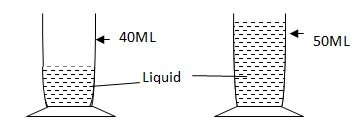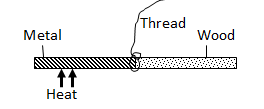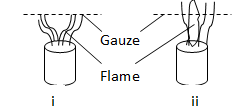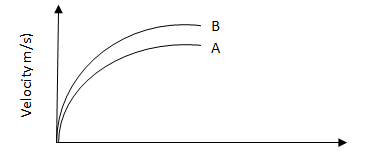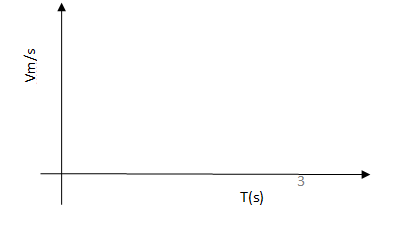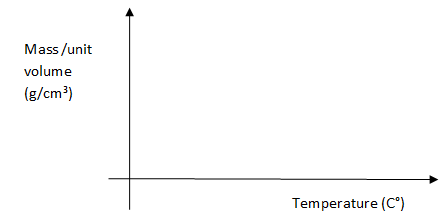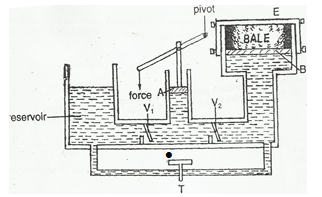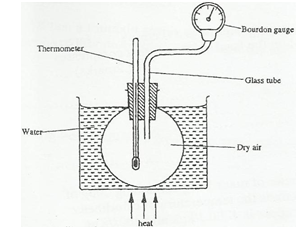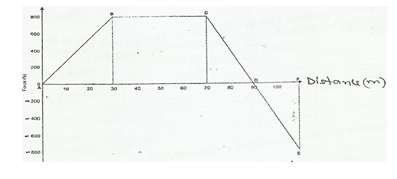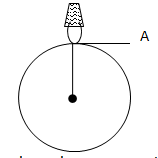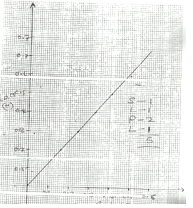SECTION A: 25 MARKS
- A stone of mass 40g was completely immersed in a liquid. The level of liquid are shown in the figure
Determine the density of the stone in SI units (2mks)
- The following figure shows a rod made of wood on one end and metal on the other end suspended freely with a piece of thread so that it is in equilibrium.
The side made of metal is now heated with a Bunsen flame. State with a reason, the side to which the rod is likely to tilt (2mks)
- Estimate the size of an oil molecule if a drop of oil of volume 6.0 × 10-10 m3 forms a patch of 32 on a water surface. (2mks)
- Other than oil patch being monolayer, sate any one other assumption in the oil drop experiment. (1mk)
- An immersion heater rated at 180W is placed in a liquid of mass 2kg. When the heater is switched on for 7.5 minutes the temperature of the liquid rises by 400C. Determine the specific heat capacity of the liquid. (3mks)
- Other than temperature state one other factor that affects the surface tension of water. (1mk)
- The figure below shows a uniform bar pivoted at its centre and is at equilibrium.
Determine the value of w. (3mks)
- When a Bunsen burner is lit below wire gauze, it is noted the flame initially burns below he gauze as shown in
- After sometime, the flame burns below as well as above the gauze as shown in
- Explain this observation (2mks)
- The figure shows the velocity time graph of two identical spheres released from the surfaces of two liquids A and B.
Give a reason why the terminal velocity of the sphere In B is higher than in A. (1mk)
- A box of mass 500g is dragged along a level ground at a speed of 12m/s. if the force of friction between the box and the floor is 2000N, calculate the power developed. (2mks)
- State how heat losses by convection and radiation are minimized in a thermos flask. (2mks)
- On the axes provided sketch a graph of velocity (v) verses time (t) for uniformly accelerated motion given that t=0,v is greater than zero. (1mk)
- Sketch on he axes provided a graph to show how mass per unit volume of water varies with temperature when water is heated from 00 to 200 (2mks)
- State how the velocity of a moving fluid varies with pressure. (1mk)
SECTION B (55 MARKS)
-
- When a fountain pen is taken in a high aero plane, it leaks. A ball point pen does not have this problem. Explain how the ball point is able to overcome this problem. (1mk)
- The fig below shows a hydraulic press used to compress a bale
- Explain briefly ho a force applied on the lever compresses the bale. (4mks)
- Given that the area of piston B is 18cm2 and that of piston A 3.0cm3. A force of 2N is applied to piston A, find the force produced on the larger piston B that compresses the bale. (2mks)
- A 180W heater is immersed in a copper calorimeter of mass 100g containing 200g of alcohol. When he heater is switched on after 36 seconds the temperature of calorimeter and its contents rises t 120 . If S.H.C of water and copper is 4200 J/kgk and 400j/Kgk respectively.
Determine:- Heat lost by the heater (2mks)
- Heat gained by calorimeter and alcohol, if the specific heat capacity of alcohol Cu. (2mks)
- The value of specific heat capacity of alcohol (1mk)
-
- State the pressure law for an ideal gas (1mk)
- The set up shows an arrangement to determine the relationship between temperature and pressure of a gas constant volume.
- Describe how pressure measurements are obtained in the experiment. (3mks)
- Explain how the result form the experiment can be used to determine the relationship between temperature and pressure. (2mks)
- A bicycle tire is pumped to a pressure of 2.2 × 105pa at230C. After a race the pressure is found to be 2.6 × 100 pa. Assuming the volume of the tire did not change, what is the temperature of the air in the tire. (3mks)
- Air is trapped inside a glass tube by a thread of mercury 240 mm long. When the tube is held horizontally the length of the air column is 240mm.
Assuming that the atmospheric pressure is 750mm Hg and the temperature is constant; calculate the length of the air column when the tube is vertical with open end down. (3mks)
-
- Define the term work (1mk)
- The figure shows a force-distance graph for a car towed on a horizontal ground
- Calculate the total work done (3mks)
- If the velocity just before reaching point C is 0.6m/s, calculate the power developed by the agent providing the force at this point. (3mks)
- The figure below shows a bottle top opener
Indicate on the diagram the direction of the load and effort. (2mks) - A block and tackle system has 3 pulleys in the upper fixed block and two in the lower movable block. What load can be lifted by the effort of 200N if the efficiency of the system is 60% (3mks
-
- State two factors that reduce the stability of a vehicle while going round a banked bend. (2mks)
- The figure shows a bucket filled with water of mass 5kg tied on a string 2.0 m long being rotated in a vertical circle with a constant speed V m/s.
Calculate the minimum speed the bucket takes to rotate in position A so that the water remains in the bucket. (3mks) - A car of mass 6000kg is driven round a horizontal curve of radius 250m. if the force of friction between the tyres and the road is 21000N, what is the maximum speed that the car can be driven at on the curve without going off the road. (3mks)
- In an experiment to investigate the variation of centripetal force with radius r of a circle in which a body rotates, the following results were obtained.
Mass(g)
60
50
40
30
20
Radius® cm
50
41
33
24
16
F(N)
R(m)
- Complete the table above (2mks)
- Plot a graph of force F against the radius (5mks)
- Given that mass of the body is 100g, use the graph to determine the angular velocity. (3mks)
- State one application of circular motion (1mk)

MARKING SCHEME
- P= m/v = 409/ 10cm3 = 4gcm3
= 400kg/m3
- It tilts to the side with woo because when metal is heated it expands and becomes lighter.
- T= v/A
= 6 x 10 -10
142.1 x (0.16)2
= 7.459 x 10- 9 m
(7.45942075 x 10- 9m)
- The molecules in oil patch are closely packed. The oil drop b a perfect sphere/the oil patch perfect circular.
- Pt = mc∆o
180 x 7.5 x 60 = 2 x e x 40
C = 1012.5J/kgk
- Impurities
- Sum of clockwise moments = sum of anticlockwise moments
(5 x 50) + 35W = 30 x 30
W = 18.57 N.
- Initially the air above the graze has not reached the ignition temperatures after sometime the heat from the graze raises the temperature above it to its ignition temperature.
- Fluid B is less viscous compared to A/A is more viscous than fluid E
- P=Fv
2000 x 12
=24000w
- Convection- having a vacuum between double walls
Radiation – shinny/ silvery walls
- Vm/s
- Mass per
40C Temperature (0C)
- Increase in velocity of moving fluid is accompanied by a decrease in pressure
-
- A ball point has a hole on the barrel which helps to balance the pressure in and outside the tube
-
- On down stroke, V1 closes and V2 opens, liquid pressure is transmitted from A to B owing to the large area of A to B, a large force is produced which compresses the bale.
- F1/A1= F2/A2
F = 12N.
-
- Heat lost by the heater
E= pt
=180 x 39
= 6,400J - Q = můCu ∆Ѳ
= 0.1 x 400 x 12 + 0.2 cu x 12
= 480 +2.4 cu - 480 + 2.4cu = 6400
Cu= 2466.67J/kgk
- Heat lost by the heater
-
- Pressure of fixed mass on gas is directly proportional to the absolute temperature provided volume is kept constant.
-
- initial pressure and temperature is noted and recorded. The bath is heated, this in turn heats the air inside the flask, the values of T and P are taken at gives intervals.
- the results obtained are used to plot a graph of pressure against temperature. A straight line graph is obtained, if temperature increases value the line passes through the origin.
- T= 76.82 0C
-
- Work done = total area under graph.
=1/2 (90 +400) 800 + ½ x 80
= 52000 + 8000
= 60, 000J - P= FV
=800 x 0.6 - Efficiency = X 100
60% ==
M.a =5
L = 600n
- Work done = total area under graph.
-
- Overloading
Overspeed - F = - mg but for minimum V, F =0
F = =mg
V =4.472 m/s - F =
21000= V
= 29.58 m/s. -
Mass (g)
60
50
40
30
20
Radius ® cm
50
41
33
24
16
F(N)
0.6
0.5
0.4
0.3
0.2
R(m)
0.50
0.41
0.33
0.24
0.16
- slope = mw2
Slope = 1.296
1.296= .1 x w2
W = - – drying of clothes in spin driver
- Centrifuges
- speed governors
- Overloading
Download PHYSICS PAPER 1 - KCSE 2019 NYANDARUA PRE MOCK EXAMINATION.
Tap Here to Download for 50/-
Get on WhatsApp for 50/-
Why download?
- ✔ To read offline at any time.
- ✔ To Print at your convenience
- ✔ Share Easily with Friends / Students

